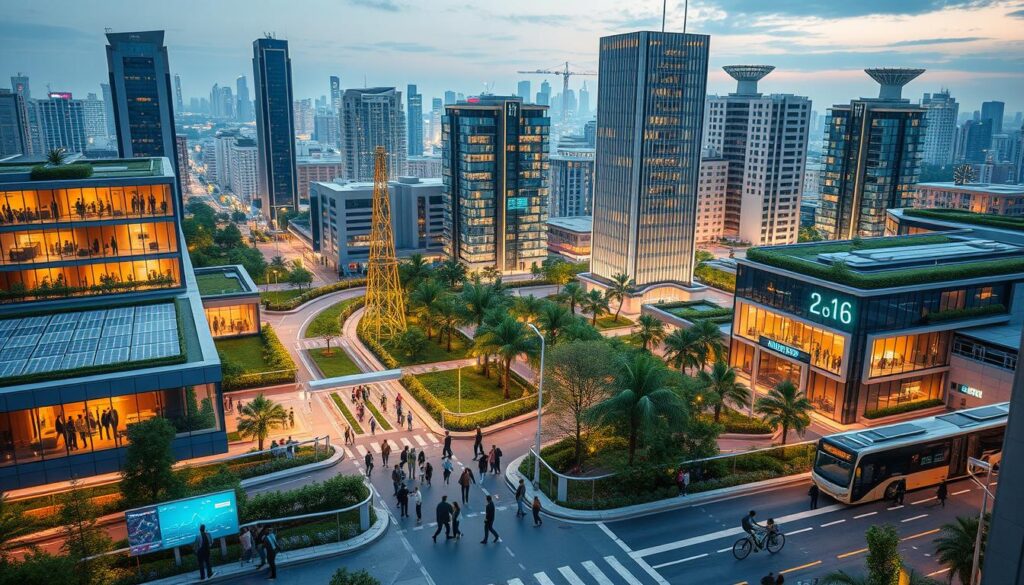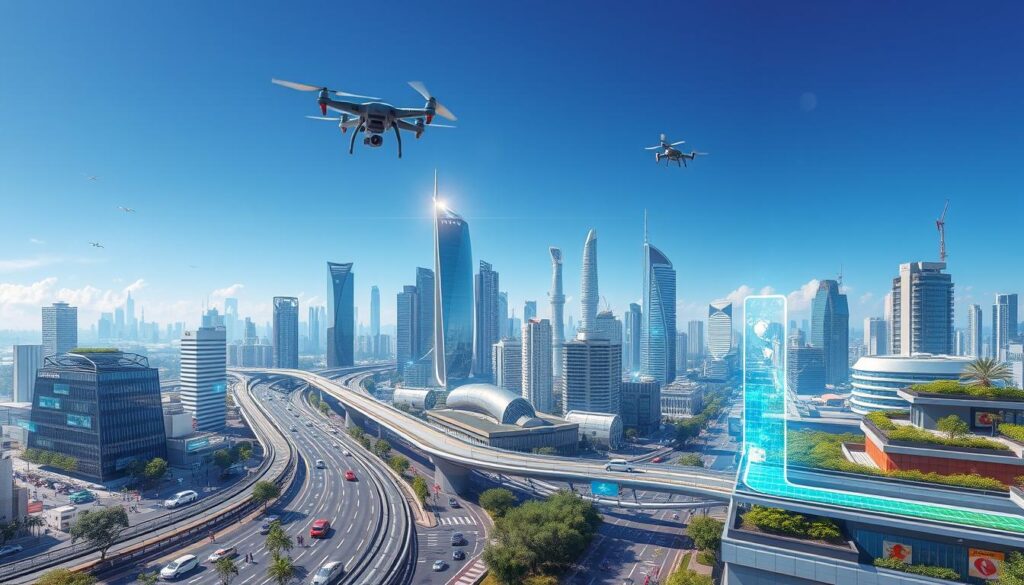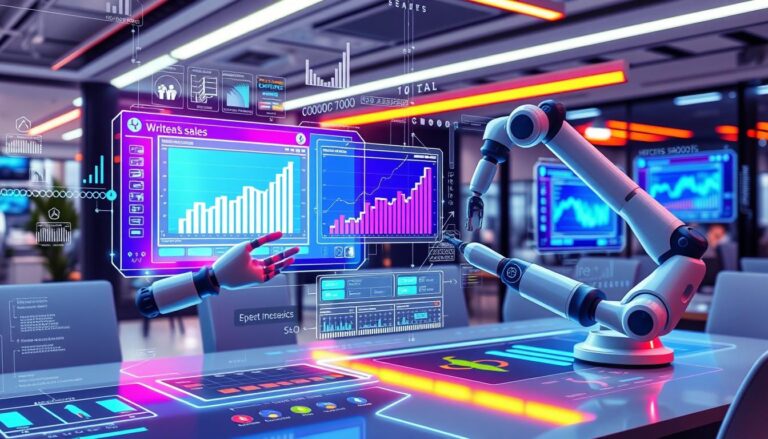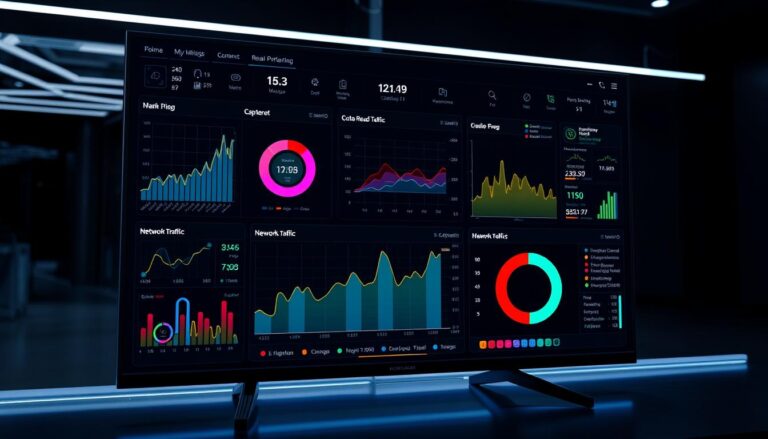Smart city app development stands at the crossroads of urban growth and tech innovation. Companies like Citytech are crucial in turning digital dreams for cities into reality. They create cutting-edge urban tech solutions. Citytech, a leader in this arena, is recognized through partnerships with big names like Microsoft, Kentico, Adobe, and nopCommerce.
Citytech has shown its prowess in projects for the Government of Sharjah and Saudi Arabia Logistic. They have brought smart city innovation to life by developing custom solutions. At places like Sharjah and in markets such as Germany, Citytech has showcased the power of IoT software. Their work has been celebrated by Kentico for creating top-notch digital experiences in cities.
Citytech blends urban infrastructure software with new techs like blockchain and AI. This mix is leading cities towards being more sustainable, secure, and smart. Cities become better for everyone, improving life quality significantly.
Key Takeaways
- Citytech’s strategic partnerships reflect a strong market position in smart city app development.
- Digital transformation for smart cities is central to creating sustainable, efficient urban spaces.
- Integration of blockchain and AI by Citytech sets a industry standard for urban technology solutions.
- Recognitions by Kentico underscore Citytech’s contribution to enhanced user experience in the smart cities sector.
- Citytech’s project portfolio highlights its instrumental role in shaping the future of IoT-driven cities.
- Significant reduction in urban challenges and advancement in quality of life can be attributed to technologies deployed by companies like Citytech.
The Importance of Software Development in Smart Cities
Urban centers everywhere are turning to smart city software to meet big challenges. They’re using technology to make cities work better and improve our lives. This tech is the foundation for building cities that are both green and efficient.
The key to this is using agile software methods. This way, cities can quickly improve their software to meet changing needs. By using microservices and strong APIs, smart cities can manage resources better and deliver needed services more effectively.
Enhancing Urban Efficiency
Smart traffic systems are a great example of how this software makes a difference. They can make travel less of a headache and reduce pollution. In fact, they can cut travel delays by up to 30% and reduce harmful gases by up to 8%.
These systems also make daily commutes quicker by up to 25%. Millions now save time getting around, all thanks to smart city software.
Promoting Sustainability
Sustainability is another big goal for smart cities. For example, smart energy systems can cut energy use by up to 30%. Smart waste management can reduce emissions by 20% too. This shows how tech can help us live in a greener world.
Putting these systems to work takes careful planning and coordination. It’s done using agile software practices and effective API use. This makes sure everything in the city works well together for a greener future.
Improving Quality of Life
The main aim of smart city software is to make life better for everyone. By blending tech into our day-to-day, we get better services, more safety, and smoother city operations. This leads to happier people and better living conditions in cities.
In summary, as cities grow, software development plays a vital role. New methods like microservices make city systems more flexible and effective. This ensures cities can meet today’s needs and be ready for the future. Thanks to software, cities can become more unified and green, offering a better life for all.
Key Technologies Driving Smart Cities
For AI-driven smart cities to improve, integrating top technologies is key. This boosts how urban services work. Key players include the Internet of Things (IoT), Artificial Intelligence (AI), and Big Data and Analytics.
Internet of Things (IoT)
IoT makes cities smarter by making them interactive. IoT software development for cities connects many devices and sensors. This allows for gathering real-time data that is crucial for planning and managing cities. It makes traffic and energy use better. It also lowers pollution and improves living standards.
Artificial Intelligence (AI)
AI changes how cities develop by using big data for predictions and automation. It processes data from urban IoT devices for quick decisions. With AI, cities can better manage traffic, ensure public safety, and offer health services that target urgent needs.
Big Data and Analytics
Big Data and Analytics help city officials make strategic decisions. They analyze data from sensors, cameras, and IoT devices to enhance urban planning. This supports sustainable growth and addresses urban challenges in specific ways.
Below is a table illustrating the various effects of deploying these technologies in smart cities:
| Technology | Effect | Impact Percentage |
|---|---|---|
| Smart Safety Applications | Reduction in fatalities and crime rates | 8-40% |
| Smart Emergency Response | Decrease in emergency response times | 20-35% |
| Smart Mobility | Reduction in commute times | 15-20% |
| Health-focused Applications | Reduction in disability-adjusted life years | 8-15% |
| Environmental Applications | Reduction in emissions and water usage | 10-15% |

Challenges in Software Development for Smart Cities
Turning urban centers into smart cities is ambitious. It comes with challenges like data privacy, integration woes, and cybersecurity issues. These challenges must be addressed to make the most of smart city potentials.
Data Privacy Concerns
Smart cities need lots of personal data to work well. This raises big privacy issues. There’s a real worry about data misuse, including the fear of government spying. Using encryption technologies and following strict rules like GDPR are key to protecting citizen data.
Integration with Legacy Systems
Linking new tech services with old systems is tough. Old urban infrastructure often can’t work well with new tech. Cities need to invest in upgrading their systems. This might mean making old systems better or getting new tech that works with the old. AI agents for compliance can help make this process smoother.
Ensuring Cybersecurity
Smart cities are more open to cyberattacks. As cities get smarter, they need stronger cybersecurity. It’s vital to build security into the city’s digital structure from the start. This includes using things like multi-factor authentication and keeping a real-time watch for threats. Training staff on security is also crucial.
Yes, there are big hurdles. But, the benefits of smart cities are huge. They can make traffic better, increase public safety, and use energy more wisely. The key is focusing on secure tech integration.
The Role of Stakeholders in Smart City Development
Smart cities thrive because different stakeholders work together. Each one offers special skills and perspectives. Understanding smart city public-private partnerships, stakeholder engagement in smart cities, and government-led urban technology initiatives is key. This helps build cities that are advanced, sustainable, and meet people’s needs.
Government Initiatives
Government efforts are at the heart of developing smart cities. They create the rules that private companies and communities follow. Governments encourage innovation. They make sure new tech is safe and useful. Their support is crucial for adding cutting-edge urban technologies.
Private Sector Collaboration
The private sector plays a key part in making smart city ideas work. IT and construction companies bring needed science and building skills. Their work makes smart cities economically possible through smart city public-private partnerships. This teamwork is important for cities to operate better and spend less.
Community Engagement
Getting the community involved is very important. Stakeholder engagement in smart cities lets residents have a voice in their city’s development. This makes sure that projects really help the people living there. It makes people feel like they are part of the changes. Workshops and feedback sessions make the process clear and fair.
| Stakeholder | Role | Impact on Smart City Development |
|---|---|---|
| Government | Regulatory framework and policy-making | Establishes a supportive environment for innovation and technology integration |
| Private Sector | Technological innovation and implementation | Drives the creation and adoption of smart solutions |
| Local community | User feedback and participation | Ensures solutions are tailored to real needs and sustainable adoption |
For a closer look at stakeholders in smart cities, see this International Journal of Information Science article. It talks about the key groups involved in governance and their roles in making cities tech-smart and inclusive.

Best Practices in Software Development for Smart City Solutions
Urban centers are evolving into smart cities. This combines agile software methods with advanced tech. It creates places that focus on being efficient and safe. Software development cycles that repeat are key. They ensure technologies meet our needs now and can adapt for future ones.
Agile Development Methodologies
Agile software methods are vital for creating smart city tech. They allow cities to adjust quickly to new needs and problems. Agile methods mean software keeps getting better. This happens through regular feedback, helping the tech grow as the city does.
User-Centric Design
Putting user experience at the heart of smart cities is essential in software development. It’s about making things that work well and are easy to use. This makes daily life better for everyone in the city.
Continuous Testing and Development
Smart city tech keeps improving through iterative development. This means testing, getting feedback, and making changes over and over. It’s crucial for fixing issues and making systems perform better as time goes on.
| Area of Impact | Technology Applied | Expected Benefit |
|---|---|---|
| Urban Efficiency | IoT, AI | Reduce operating costs by integrating real-time data management. |
| Risk Management | Cybersecurity Measures | Minimize vulnerabilities and protect against cyber threats. |
| Environmental Sustainability | Intelligent Energy Solutions | Improve energy efficiency by 30% over the next two decades. |
| Public Safety | Smart Traffic Systems | Decrease in traffic-related incidents, exemplified by Paris’s 40% reduction in traffic deaths. |
Following these best practices helps smart cities do more than harness technology. They turn into ecosystems where tech meets the needs of the people. This creates innovative, safe places aimed at community well-being over the long term.
Case Studies of Successful Smart City Implementations
Exploring successful smart city case studies sheds light on urban living’s future. Cities use advanced technology to meet urbanization’s challenges. Barcelona, Singapore, and Austin show how tech improves living standards.
Barcelona: A Model for Urban Innovation
Barcelona is known for its use of IoT and urban apps. Its extensive fiber optic network boosts connectivity. This supports the Sentilo platform, connecting over 18,000 sensors to track city metrics.
The city has seen a 25% rise in water conservation and more jobs. Barcelona leads in making cities more sustainable and livable.
Singapore: Smart Nation Initiatives
Singapore’s Smart Nation vision showcases holistic city planning. By blending digital tech, connectivity, and data, it fosters a proactive ecosystem. This affects everything from traffic to healthcare.
The smart city model empowers its society through technology. This improves living conditions for all residents.
Austin: Smart City Planning
Austin emphasizes community engagement and environmental care. With free Wi-Fi in parks and electric fleets, it sets new standards. The city focuses on sustainable energy in its grid.
It illustrates the power of tech to improve city life and resilience. Austin’s strategies offer lessons on using technology for urban development.
Smart cities are transforming urban areas in the U.S. and globally. From Dallas’s water tech to San Francisco’s green energy, these efforts show tech’s impact. By analyzing cities like Barcelona, Singapore, and Austin, we learn strategies for urban improvement. For example, Hull’s evolution into a programmable city shows the importance of partnerships and infrastructure.
FAQ
What is involved in smart city app development?
Smart city app development is about making apps that connect with smart city systems. These apps help manage services, boost operations, make cities sustainable, and improve residents’ lives. They use things like IoT, AI, big data, and focus on users’ needs.
How does digital transformation benefit smart cities?
Digital transformation updates city services and infrastructure with new tech. It makes city operations more efficient, helps the environment, and improves life for people. Cities become more accessible and satisfying to live in.
What urban technology solutions are vital for modern cities?
Important urban tech includes IoT for connecting systems, AI for smart decisions, big data for insights, and software for managing services. These technologies make cities more responsive and adaptable.
Why is smart city software development crucial for urban efficiency?
Smart city software is key for efficiently running city services. It uses agile methods and API integration for smooth experiences. Microservices make it easy to adjust as cities’ needs change.
In what ways does promoting sustainability through technology impact smart cities?
Tech helps cities use less resources, save energy, and make less waste. This approach leads to greener cities and protects the environment.
How does software development improve the quality of life in urban areas?
Software makes city services better, offering convenience, safety, and easy access. It helps in areas like healthcare and transportation, making city living efficient.
How does the Internet of Things (IoT) contribute to smart city development?
IoT lets cities collect real-time data for improving services and infrastructure. This makes cities run better and quickly respond to what people need.
What is the role of Artificial Intelligence (AI) in developing AI-driven smart cities?
AI analyzes city data to find patterns, forecast future events, and make processes automatic. It helps cities make smart choices, enhancing safety and sustainability.
How are big data and analytics applied in smart city strategies?
Smart cities use big data and analytics to understand huge amounts of information. This helps in making good policies, running cities well, and planning ahead.
What are the challenges with data privacy in smart city innovation technology?
Keeping personal data safe in smart cities is tricky. Using strong encryption and ethical practices is critical to keep people’s trust and use data responsibly.
Why is integrating with legacy systems a hurdle in smart city software development?
Old tech systems don’t work well with new smart city technologies. Solving this means updating or changing old systems to work with new tech.
How is cybersecurity ensured in smart city technologies?
To protect smart city tech, strategies include constant monitoring, strong security measures, planning for incidents, and updating software to stop cyber threats.
What is the significance of government initiatives in smart city development?
Governments are crucial in smart city development by leading, funding, regulating, and encouraging partnership between public and private sectors. This makes sure smart city projects benefit everyone.
How does private sector collaboration enhance smart city projects?
Collaboration with the private sector brings expertise, innovative ideas, and funds. Together, they can implement tech solutions that improve city life.
Why is community engagement important in the digital transformation of cities?
Engaging the community ensures tech solutions meet real resident needs. Feedback and support from citizens help build cities that everyone can enjoy.
What makes agile development methodologies suitable for smart city solutions?
Agile methodologies fit well with smart city projects. They support quick changes, early releases, and constant improvement, important in fast-changing city environments.
How does user-centric design benefit smart city applications?
Designing with users in mind makes sure city tech is easy to use and truly helpful. It increases user happiness with city services.
Why is continuous testing and development important for smart city innovation?
Continuous work on smart city tech keeps apps working right, safe, and up-to-date with urban and user needs, making cities better places to live.
What can we learn from Barcelona’s approach to urban innovation?
Barcelona teaches the importance of using IoT and making apps for city services. Their approach shows integrating tech improves life for city residents.
How has Singapore’s Smart Nation initiative influenced smart city development?
Singapore shows that full digital plans, citywide connectivity, and analytics optimize services and management. It sets an example for other cities to follow.
What are the key takeaways from Austin’s integration of technology in urban planning?
Austin shows smart use of tech in planning requires new ideas and teamwork. Including different voices helps create a connected and modern city.



